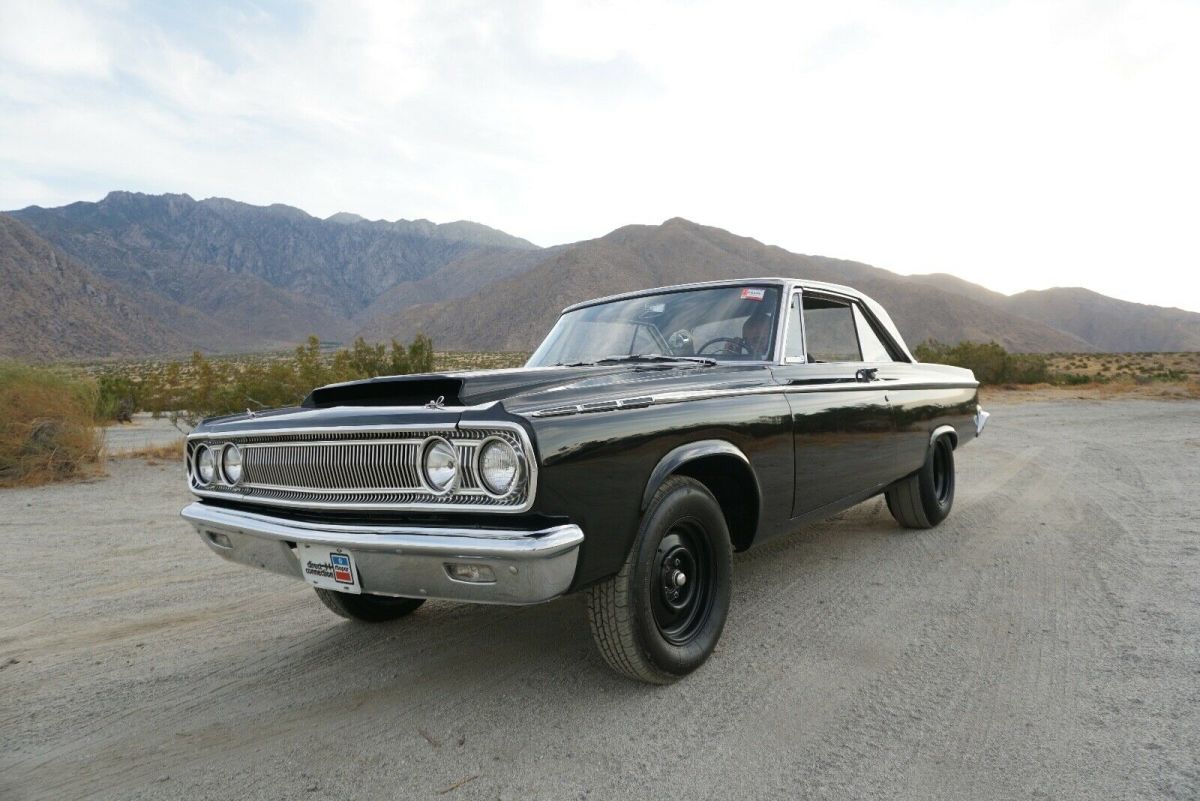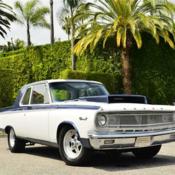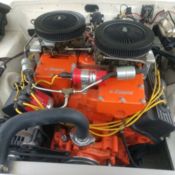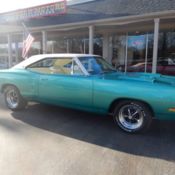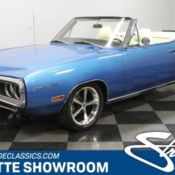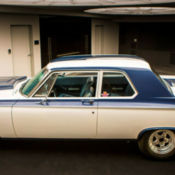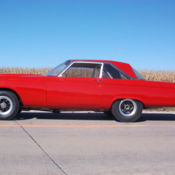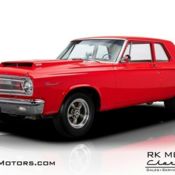1965 Dodge Coronet 500 Hemi - Grand Spaulding Dodge produced - 426 hemi 4-speed
1965 Dodge Coronet Coronet 500
2020 July issue of Hot Rod Magazine cover car and center spread- The car was originally built as a 1965 Coronet 500 with a Street Wedge 426ci/365hp engine, a four-speed transmission, and lots of cool performance stuff.
- The car was delivered to the new owner by the famous folks at Mr. Norms Grand Spaulding Dodge in Chicago, as documented by the original factory punch card that came with the car.
- At some point it was upgraded with a date-coded 1966 426cid Hemi engine dressed with twin Holley carbs on a chromed cross ram intake, a 1970s date-coded Dana 60 rearend, and a fiberglass front that includes the very cool drag raceinspired hoodscoop.
During the late 1950s and 1960s, the number of car dealerships jumped dramatically across the country. Manufacturers reasoned that if prospective buyers had a dealership in their neighborhood, the companies would sell more cars. In this Golden Age of American car production (1955-1970), some dealerships began to focus on performance cars as a way to generate additional traffic. Yenko in Pennsylvania, Motion in New York, Dana in California, Royal in Michigan, Galpin in California, and others all specialized in delivering high-powered cars to a thirsty public. Most importantly, car manufacturers took advantage of this specialization, creating unique cars with bigger engines and other performance options to help push cars.
For Mopar fans, no dealer was more performance-oriented than Norm Kraus's Grand Spaulding Dodge in Chicago, which opened in 1962. At the corner of West Grand and North Spaulding Avenues on the west side of Chicago, what started out as a dirt lot was to become the place where "Hemi" and "Max Wedge" were spoken fluently and black tire marks on the surrounding street simply signaled a successful test drive. To that end, Mr. Norm's service department would performance-tune each car before delivery on their not one but two onsite Clayton dynamometers. It was not long before Grand Spaulding Dodge became the highest-volume performance Dodge dealership in the U.S.
Along with the street-worthy high-performance Dodges that rolled off the lot, Mr. Norm believed that racing was good for business. Mr. Norm considered racing to be his favorite marketing tool. Together with his friend and fellow Chicagoan Gary Dyer, Grand Spauldingsponsored racecars became a common sight on race tracks around the country for several decades. From factory Super Stock through Altered, Factory Experimental machines and on to nitro-burning Funny Cars, the "win on Sunday, sell on Monday" mentality was in full force at Mr. Norm.
Racing and performance cars drove sales of production cars in the 1960s and into the early 1970s. To feed the frenzy, Mr. Norm offered racing parts that were prototyped in its facility for racers worldwide. In kind, Chrysler began offering these parts for sale to other dealerships and customers. Specialty racing-oriented engines, lightweight body parts, and stronger suspension and drivetrain parts all brought a higher level of clientele that would generate money for these "enthusiast" products.
To chase down additional information concerning how Toles' current Dodge came to be, we turned to longtime current Mr. Norm vehicle expert Larry Weiner, who to this day carries on the work of the famous Chicago dealership. (In fact, if you want to create the ultimate late-model Dodge, Charger, or Challenger, Weiner will take your order and build you a documented, certified, tire-melting machine. Check him out atmr.norms.com).
So we sent over the photos that you see here to Weiner and asked a few questions about how this car may have come to its current form. Weiner was a racer back in the day and knew all the players, including Kraus and Dyer. Over the years he has seen quite the assortment of cars but delivered a sad fact that was to make the rest of our investigation considerably tougher.
"A fire destroyed all of the paperwork surrounding the legacy of Mr. Norm's car sales in 1968," notes Weiner. "For that reason there's no way to tell if a car prior to that year was originally ordered by the dealership. Even worse, there's no way to tell how many cars were actually created. This makes it hard to prove if any car came from the dealership unless the car retains the original sales documents. Even the stickers that the dealership would proudly apply to the cars as they left the lot really hold no significance since reproductions are common."
Toles' Dodge is one of the lucky ones. The original Grand Spaulding Dodge invoicing material is still with the car, including the all-important IBM punch card that was required to order the car from the factory. But, as noted earlier, it would require significant sleuthing to figure out the root the engine, body, and rearend changes made to the car.
"It is clear that the changes to the car, such as the rearend, were done sometime after 1970 due to the date coding on the part," continues Weiner. "The bellhousing is a hydro-formed unit with a block plate, which would have been popular around the early 1970s, the earlier cars using the Ansen cast iron units for clutch safety."
If the upfits to the Hemi engine were done in the 1970s, as would seem to be the case, then finding a 1965 Dodge K-member to accept a 1966 Hemi engine might not have been so easy. As our car demonstrates, the modifications required to make it fit were extensive. Weiner notes that Mr. Norm's shop did use the Milodon oil pans of this type on its builds, but so did a lot of other folks during the era.
"I made a call over to Norm Kraus, the original Mr. Norm, and asked him about the car," says Weiner. "He's 86 years old and still excited about cars. He believes that due to the crude nature of cuts made to K-member to fit the Hemi engine, that the upgrades would not have been completed at Grand Spaulding Dodge. In addition, things like the rear welded wheels would not have been used—most customers would have bolted up a set of Cragar S/S five-spokes and sent him down the road."
So will the mysterious "customizer" of the Hemi-powered Dodge Coronet come forward? Time, and perhaps this article, will hopefully reveal that answer.
Fast Fasts
1965 Dodge Coronet 500
Brad Toles, Palm Springs, CA
Engine
Type: 426ci Hemi; 1966 date code (original engine: 426ci Street Wedge)
Bore x Stroke (in. ): 4.250 x 3.750
Block: 426ci Hemi block
Rotating assembly: Original Street Hemi engine components including factory forged crankshaft, rods, and aluminum alloy pistons
Cylinder heads: Original Mopar Street Hemi engine components
Compression: 10.25:1
Induction: Chrome-plated cross ram intake manifold with twin 600-cfm Holley carbs
Oiling system: Milodon high-volume race oil pan with high-pressure pump and internal windage tray
Exhaust: Hooker slip fit headers into twin mufflers and complete exhaust; car was originally equipped with fenderwell headers
Ignition: ACCEL ignition with Mopar regulator
Drivetrain
Transmission: Original New Process A833; 18-spline input shaft
Shifter: Hurst 4-speed original
Driveshaft: Factory original
Reared: Original Dana 60 with 4.11:1 gearing, Sure Grip, date-coded 1970
Chassis
Front suspension: Factory original with factory-correct markings.
Rear suspension: Factory original with Hemi
Front brakes (in. ): 10x2.5 factory drum brakes
Rear brakes (in.) 10x2 factory drum brakes
Body
Fiberglass front end: Perhaps Mr. Norm?
Paint: Factory/dealership paint
Paint: Factory black
Interior
Instrumentation: Factory original cluster radio-delete panel; Moroso Tach and auxiliary aftermarket gauges
Upholstery: Factory original-style vinyl bench seat
Wheels: 5x15 steel wheels in front, 10x15 widened and welded steel wheels in rear
Tires: 205/70-15 Cooper Trendsetter Radial in front, P295/50R-15 McCreary Mini Star in rear
- Make: Dodge
- Model: Coronet
- SubModel: Coronet 500
- Type: Coupe
- Trim: Coronet 500
- Year: 1965
- Mileage: 19200
- Color: Black
- Engine size: 426cid Hemi
- Number of cylinders: 8
- Power options: 426cid Hemi - 1966 dated block
- Fuel: Gasoline
- Transmission: Manual
- Drive type: RWD
- Interior color: Black
- Drive side: Left-hand drive
- Options: fiberglass fenders and hood from factory
- Vehicle Title: Clean Want to buy? Contact seller!
